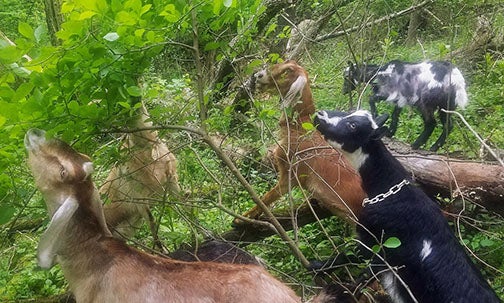 This fall, two herds of goats will visit the University of Pittsburgh at Greensburg to clear hillsides of weeds and invasive plants. The goats will begin their work on September 24 and will stay approximately four weeks until the designated areas are clear. The herds will be accompanied by Hobo and Diamond, two mini donkeys whose jobs are to protect the herd.
This fall, two herds of goats will visit the University of Pittsburgh at Greensburg to clear hillsides of weeds and invasive plants. The goats will begin their work on September 24 and will stay approximately four weeks until the designated areas are clear. The herds will be accompanied by Hobo and Diamond, two mini donkeys whose jobs are to protect the herd.
The goats, who all have names, and donkeys will be stationed in various locations on campus, using portable enclosures that include shelter and access to water. Their job—eat the weeds and invasive plants in places where humans using machinery might be in danger. Because they are ruminants (meaning they eat, rest, chew their cud, then eat again), the goats are able to graze 20 hours out of a 24-hour period—making them efficient weed-eaters (pardon the pun!).
“Using goats as a component of our facilities management plan does several things for us,” said Joseph Bleehash, director of Facilities Management. “First, the goats are a safe alternative to having our facilities staff using riding lawn mowers on a hillside or scaling a hillside to use trimmers on an area. Second, it is a sustainable option because it cuts down on our use of gas-powered equipment, which means we are reducing our carbon footprint.”
Bleehash also encourages goat watchers to follow the progress of our four-footed guests on Pitt-Greensburg’s social media accounts, including Twitter (@Pitt_Greensburg and @UPG_Facilities) and on Instagram (@pittgreensburg and @UPG_Facilities).
The goats, a combination of Nubian, Nigerian Dwarf, Kaanan, breeds, in Team Hobo and Team Diamond will be weeding—er, grazing—in four areas:
• The hillside at the rear of the Academic Village that follows Lynch Drive;
• The lower Lynch Drive area near the Tossatto Walkway Bridge;
• The hillside in front of Robertshaw Residence Hall;
• The shallow gully that runs from the stone bridge in front of Millstein Library to North Campus Road.
Goats are actually “browsers” who are drawn to the most nutritious plants in their vicinity, and these happen to be weeds, bushes, leaves, and barks of trees. The list of plants that they will eat includes nuisance plants like bull thistle, poison ivy, and poison oak, as well as invasive plants like knotweed, honeysuckle, and multiflora rose.
“Goats will eat the plants down to the roots, which remain in the ground and prevent erosion,” said Bleehash. “The goats also will graze as high as they can reach, which is about six-feet-high when they stand on their hind legs. Water serves as a natural barrier to them, so we will have some temporary ramps in place where their grazing location requires them to move between both sides of Slate Run on our campus.”